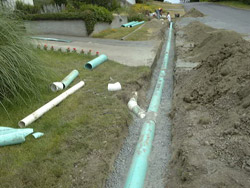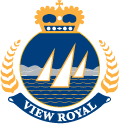Sewer & Drainage
Sanitary Sewers
View Royal's Sewer System
 View Royal's sewer system consists of approximately 50 kilometres of pipeline and 17 pump stations which are electronically monitored on a continual basis. In addition to the Town managed system, there are also privately managed sewer grinder pumps on properties that are lower than the gravity sewer system. All sewage from View Royal flows through the Capital Regional District (CRD) sewage system through the Craigflower Pump Station at Shoreline Drive and then on to McCauley Point in Esquimalt.
View Royal's sewer system consists of approximately 50 kilometres of pipeline and 17 pump stations which are electronically monitored on a continual basis. In addition to the Town managed system, there are also privately managed sewer grinder pumps on properties that are lower than the gravity sewer system. All sewage from View Royal flows through the Capital Regional District (CRD) sewage system through the Craigflower Pump Station at Shoreline Drive and then on to McCauley Point in Esquimalt.
Inflow & Infiltration
Inflow and infiltration (I&I) occurs when storm water flows into the sanitary sewer system. This may occur through cracks in pipes (infiltration) or through a homeowner's storm drainage pipe being connected to the sanitary sewer system. This results in high sewer flows during storm events.
I&I is a serious issue because every component of the sewer system must be designed to handle the maximum flows. This includes pipe sizes, pump sizes and even the new proposed regional sewage treatment facilities. The cost implications are very significant. Any reduction in I&I will result in a corresponding reduction in the proportion our taxpayers will have to pay for the upcoming sewage treatment facility (to be built by the Capital Regional District).
The Town's I&I Program is designed to reduce the amount of storm water that is flowing into the sanitary sewer system. Through a combination of smoke testing and dye testing, the Town is determining the specific causes of this issue. Once the causes are identified, remediation takes place.
If you require a sewer connection for your property, complete a Sewer Connection Permit Application Form by clicking here.
Drainage
View Royal's Drainage System
View Royal's drainage system consists of approximately 30 kilometres of pipeline as well as many swales, ditches, raingardens and wetlands.
There are two main functions of the drainage system - handling water quantity, and improving water quality. These can be related to heavy and light storms.
During heavy rainfall events, the drainage system needs to provide a means of safely conveying storm water away from homes and other areas where it could cause flooding. The Town's Master Drainage Plan was developed while considering the potential affects of climate change. This is reflected in the sizing and prioritization for upgrades to the existing drainage pipes.
During light rainfall events, there can be a high concentration of pollutants that have the potential to be toxic to riparian and marine life. This is particularly true in the first rainfall after a prolonged period of sunny weather. Oil separators and bio-treatment facilities (swales, rain-gardens and wetlands) are all recognized methods for limiting the concentration of pollutants that reach natural watercourses. Of these methods, the bio-treatment facilities are most effective in removing all types of pollutants, whereas the oil separators will remove oil and grit when properly maintained.
If you require drainage connections for your property, complete a Drainage Connection Permit Form by clicking here.
For information regarding sewer fees, click here to visit the User Fees page.
For more information:
- Engineering Department
250-708-2258
engineering@viewroyal.ca

